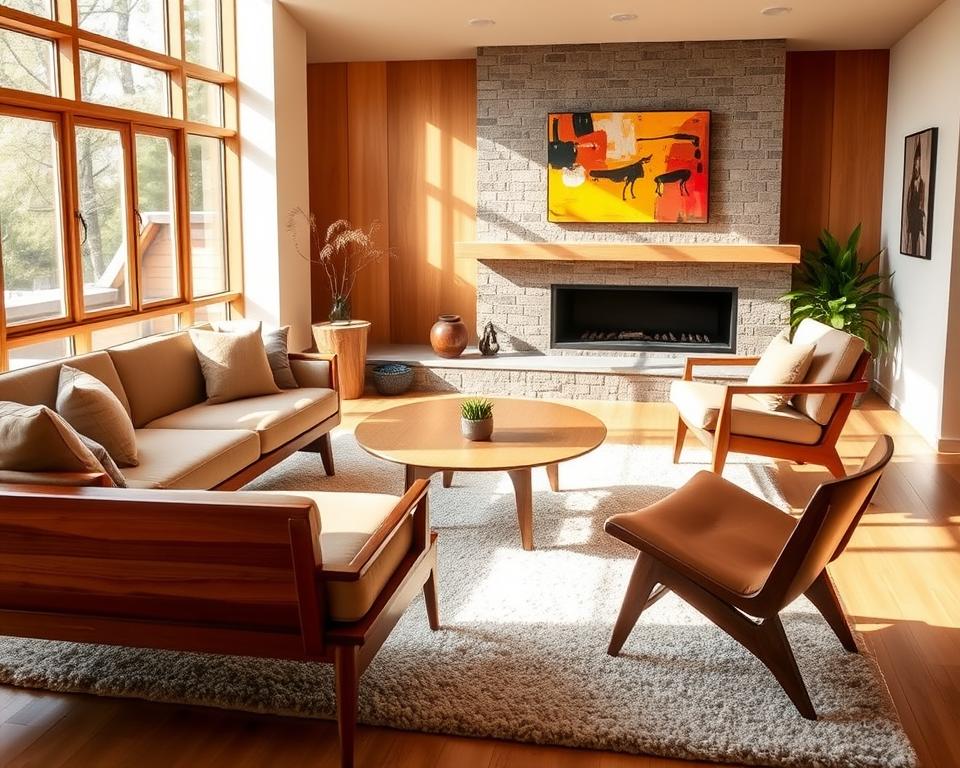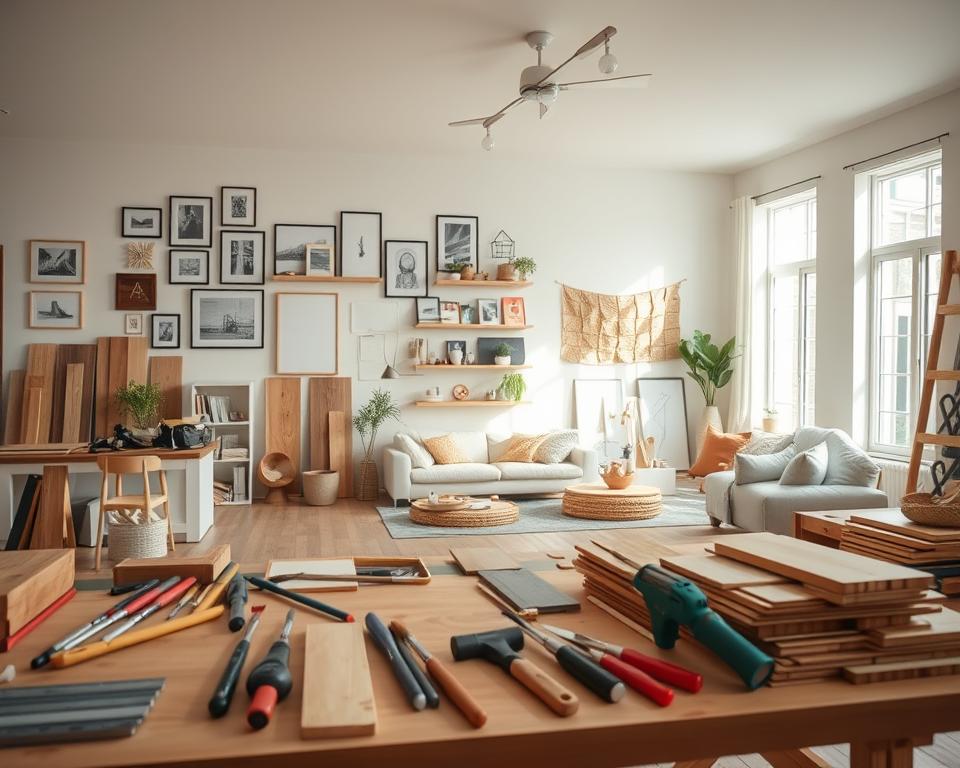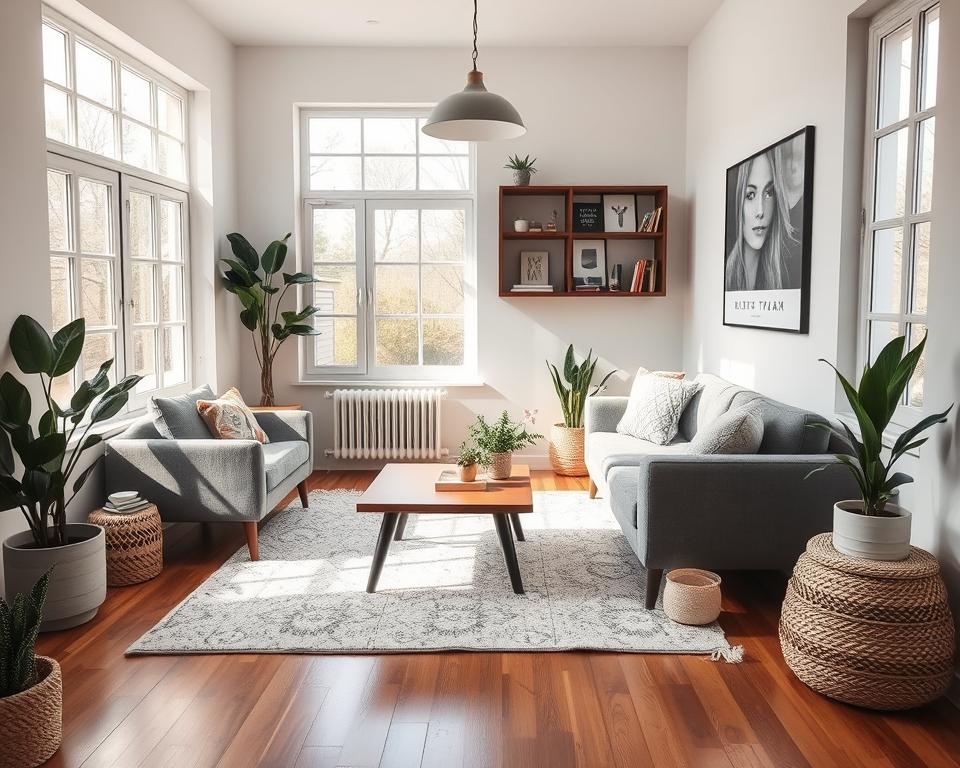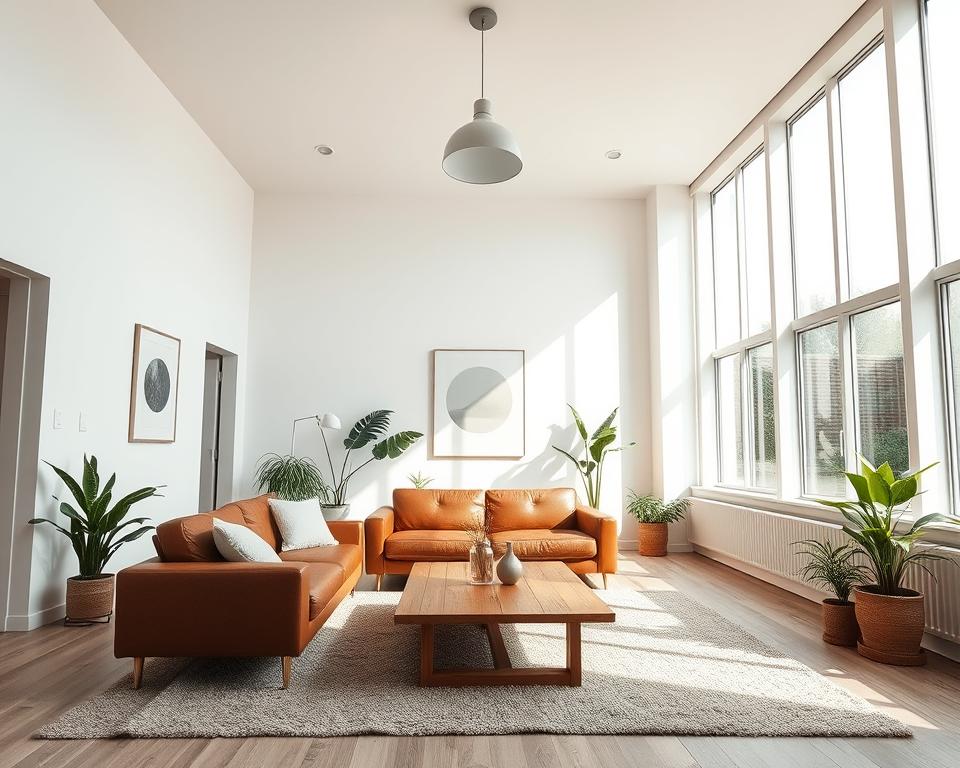Interior design styles are key in making our homes look good and work well. We have classic design, with its timeless beauty, and contemporary design, which is all about modern simplicity. Each style has its own look, colors, and furniture, letting us show who we are. This article will help you pick the perfect style for your home.
Key Takeaways
- Understanding interior design styles enhances your ability to create a tailored space.
- Classic design emphasizes timeless elegance and refined aesthetics.
- Contemporary design focuses on sleek lines and modern materials.
- Selecting the right style can reflect your personality and lifestyle.
- Color palettes greatly influence the mood and ambiance of a space.
- Furnishings play a crucial role in defining each design style.
- Combining styles can lead to a unique and personal home environment.
Introduction to Interior Design Styles
Exploring interior design styles is key for homeowners and professionals. It helps create spaces that show off personality and work well. Design shapes mood and atmosphere, turning a simple space into a welcoming place.
Knowing different styles helps make choices that match your taste. This improves the look of your home.
Understanding the Importance of Design Styles
Interior design styles greatly affect how we see spaces. Things like colors, furniture, and layout shape the feel of a room. Knowing about design styles lets you make spaces that make you feel good.
It’s important to pick a style that fits your taste and the space’s needs. This creates a balanced and comfortable living area.
How to Choose the Right Style for Your Space
Finding the right interior design style can be tough. Start by thinking about what you like. Look at your space’s architecture and how it affects your design choices.
Think about how the style will work in your daily life. These factors help you choose a design that’s both useful and beautiful.
Classic Design Style
The classic design style is all about timeless elegance. It’s known for its refined details and rich textures. This style focuses on symmetry and balance, making spaces feel both comfortable and sophisticated.
Key Characteristics of Classic Design
In classic design, you’ll notice:
- Symmetry in layout and furnishings
- Rich wood finishes showcasing craftsmanship
- Luxurious fabrics like silk and velvet
- Ornate moldings and architectural details
- A mix of modern and antique pieces
Popular Color Palettes for Classic Interiors
Classic color palettes are warm and deep. Some top picks are:
- Burgundy and cream for a regal look
- Forest green and gold for a lush vibe
- Soft beige and deep navy for understated elegance
- Muted pastels that add to wooden tones
Furniture Choices for Classic Aesthetics
For classic interiors, choose furniture that shows heritage and elegance:
- Ornate wooden tables with carved details
- Upholstered sofas with traditional patterns
- Antique-style cabinets as statement pieces
- Elegant dining sets made from solid wood
Modern Design Style
Modern design is all about simplicity and function. It’s known for clean lines and open spaces. This style focuses on keeping things simple, making your home feel more open and organized.
Defining Features of Modern Design
Modern design has a few key features:
- Clean lines for a sleek look.
- Open floor plans for better space use.
- A neutral color scheme, like whites, grays, and blacks.
- Little decoration to keep things simple.
Essential Materials in Modern Interiors
Choosing the right materials is key for modern design. Here are some common ones:
| Material | Characteristics |
|---|---|
| Glass | Makes spaces feel open and lets in light. |
| Steel | Is strong and looks sleek and industrial. |
| Concrete | Gives a raw, modern look. |
How to Incorporate Technology in Modern Spaces
Adding tech to your home makes it more functional. Consider these features:
- Smart thermostats for better temperature control.
- Automated lights for easy convenience.
- Advanced security systems for safety.
Contemporary Design Style
The contemporary design style is always changing, unlike modern design. It’s not stuck in one look. This means every contemporary space is unique, thanks to its ability to blend many styles.
Differences Between Modern and Contemporary
Modern design sticks to a certain look from the early 20th century. But contemporary design is all about mixing things up. It’s about being fresh and reflecting today’s values, like being green and innovative.
Color Trends in Contemporary Design
Colors are key in contemporary design. Today, people love:
- Bold colors like emerald green and deep navy
- Warm neutrals for a calm base
- Bright accents in accessories or art
This mix makes spaces feel alive and balanced. It shows the lively spirit of contemporary art.
Art and Decor in Contemporary Spaces
Art is a big part of contemporary design. It’s all about pushing boundaries and being new. Decor like sculptures and installations add a personal touch, making each space special.
Minimalist Design Style
Minimalist design focuses on simplicity and function. It aims for a clean, uncluttered space. This style helps create calm areas where you can focus better.
The Philosophy Behind Minimalism
Minimalism teaches us to value what’s important. It’s about choosing quality over quantity. This way, our homes become peaceful and clear.
Essential Elements of Minimalist Interiors
- Functional furniture with clean lines
- Neutral color palettes that promote calmness
- Open layouts that enhance spaciousness
- Quality materials that stand the test of time
Tips for Achieving a Minimalist Look
To get a minimalist look, start by getting rid of things you don’t need. Choose furniture that does more than one thing. Use a few colors to keep things simple and organized.
Industrial Design Style
Industrial design style brings the feel of city life into homes. It combines raw materials with practical design. You’ll see exposed brick, metal, and wood. It’s loved for being real and useful, fitting well in many places.
Key Traits of Industrial Design
Here are the main features of this style:
- Raw Materials: Unfinished surfaces and natural textures add charm.
- Open Spaces: High ceilings and open areas feel spacious.
- Neutral Color Palettes: Grey, black, and white are common, creating a calm look.
Ideal Spaces for Industrial Aesthetics
Best for industrial looks are old warehouses, lofts, and city apartments. These places show off the style’s unique qualities. They let creativity shine while keeping an industrial vibe.
How to Blend Industrial with Other Styles
Mixing industrial with other styles makes spaces unique. Here are some tips:
- Mixing Textures: Mix metal with soft materials like fabric for a cozy feel.
- Contrast with Warmth: Add warm colors or rustic furniture to balance out the industrial look.
- Layered Accessories: Add eclectic decor to show your personal touch in an industrial setting.
Bohemian Design Style
The bohemian design style brings warmth and creativity to any space. It’s perfect for those who love to express themselves. This style combines art and culture, featuring unique textures, colors, and personal touches.
Here, we’ll dive into what makes bohemian spaces special. We’ll look at color and pattern choices. And we’ll share tips for making your space both free-spirited and cozy.
Characteristics of Bohemian Interiors
Bohemian interiors are all about mixing different styles. You’ll find woven textiles, reclaimed wood, and colorful rugs. Furniture often comes from different cultures, adding to the artistic feel.
Accessories are key, with plants, artwork, and artifacts telling your story. This mix of elements creates a space that’s truly yours.
Color and Pattern Combinations in Bohemian Design
Bohemian design loves bold colors and patterns. Think rich jewel tones, earthy shades, and bright colors that work well together. Combining floral with geometric or tribal patterns adds excitement.
Layering fabrics in different colors adds depth and richness. This makes your space visually interesting and inviting.
Creating a Comfortable Bohemian Space
To make your home cozy, focus on warmth and comfort. Use big cushions, floor pillows, and textured throws. Arrange seating in cozy groups to encourage chats.
Adding cozy lighting, like fairy lights or lanterns, makes the space even more welcoming. A mix of eclectic and cozy elements makes your bohemian space both personal and relaxing.
Rustic Design Style
Rustic design brings the countryside’s warmth indoors. It creates a cozy atmosphere with welcoming elements. These elements connect us to nature.
This style often uses natural materials and handcrafted pieces. This makes a space feel inviting.
Understanding Rustic Design Elements
Key elements of rustic design include wood beams, stone accents, and vintage furnishings. These features create a homely feel. They reflect a simpler, more relaxed lifestyle.
Imperfections are celebrated in rustic design. This highlights the beauty of natural materials and handcrafted work.
Integrating Natural Materials in Rustic Spaces
Natural materials are vital in rustic design. Reclaimed wood, stone, and textiles like linen and wool are popular. These materials are durable and connect us to the environment.
Popular Rustic Color Schemes
Rustic color schemes feature earthy tones and muted hues. Shades of green, brown, and cream create a serene atmosphere. Deep reds and burnt oranges add warmth and interest.
These colors work well with natural materials. They make the space feel welcoming.
Mid-Century Modern Design
Mid-century modern design is all about simplicity and organic shapes. It’s known for sleek lines and mixing materials. This style came out in the mid-20th century, showing a sense of hope. It’s a great blend of looks and use for today’s homes.
Features of Mid-Century Modern Style
This style has unique features like tapered legs and big windows for light. It also has open floor plans for easy movement. The look is clean and simple, inspired by nature.
Furniture Icons of the Mid-Century Era
Some furniture pieces from this time are famous and eye-catching. Think of the Eames Lounge Chair, Noguchi Coffee Table, and Tulip Table by Eero Saarinen. They’re comfy and stylish, making them perfect for any room.
How to Accessorize Mid-Century Modern Spaces
Decorating mid-century modern spaces needs careful thought. Pick decor that goes well with the furniture but doesn’t take over. A vintage art piece or wood and metal can add to the look. Adding some modern touches can make the space welcoming and personal. For more on this design, check out more details on mid-century modern design.

Eclectic Design Style
Eclectic design is all about mixing different styles to create something unique. It lets people show off their personality by combining various genres, patterns, and textures. This way, ordinary spaces become extraordinary, filled with creativity and harmony.
What Defines Eclectic Design?
Eclectic design celebrates diversity. It breaks free from traditional rules by blending different elements. For example, you might pair a vintage lamp with modern furniture or mix bohemian textiles with minimalist decor. The goal is to make a space feel welcoming and cohesive, even with its variety.
Mixing and Matching Different Styles
Getting the mix right is key to an eclectic look. It’s important to find balance to avoid chaos. Choosing a main theme or color can help tie everything together. This way, each piece adds to the overall look, creating a sense of unity.
Tips for Achieving an Eclectic Look
- Choose a common color palette to tie different pieces together.
- Incorporate items from various eras and places for added interest.
- Utilize art to create focal points that draw the eye.
- Layer textures to add depth and dimension to your space.
- Be intentional with spacing to avoid overcrowding elements.
Conclusion: Finding Your Unique Style
Interior design is like a canvas for you to show who you are. As you look at styles like Japandi and maximalism, think about how your personality shapes your choices. Your style is about what you love, making your home a true reflection of you.
Looking ahead, design trends like sustainability and smart tech are big. Designers are adding tech to homes for flexibility and personal touch. This mix of function and creativity makes your space special.
To find your perfect design, check out resources that help you discover your style. Visit this guide to learn how to make your home truly yours.



